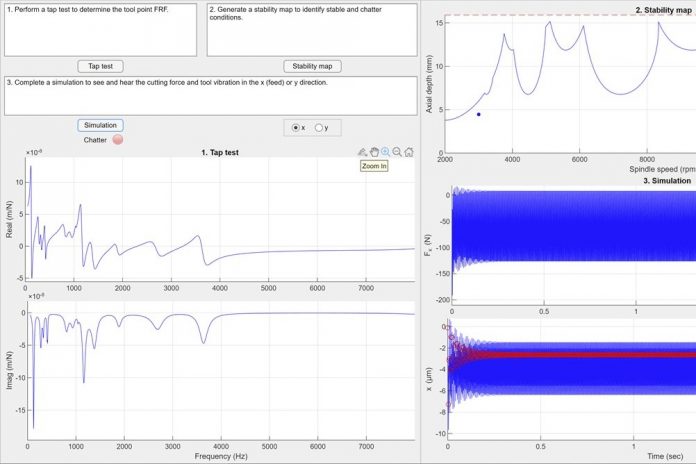Program is a response to skills gap in machining. Training reflects modern, high speed CNC machining by accounting for machine tool dynamics as part of the needed foundation.
#workforcedevelopment
Peter Zelinski
Around the mid-1990s, something fundamental changed in the nature of machining. Machine tools — specifically, CNC machining centers — became widely capable of milling at sufficiently high spindle speeds and metal removal rates that the dynamics of the machining system started to matter. Process characteristics related to vibration and natural frequency became potentially significant for determining the performance of the cut.
Machining fundamentals have never quite caught up. Machining fundamentals as they are typically taught still tend to assume a milling pass as it might be performed on a manual mill, in which the tool can be modeled as a rigid cylinder and the part can be modeled as a rigid prism. The reality: In CNC machining, if the milling pass is programmed to run at what might be considered a reasonable production rate in aluminum or steel today, then the tool is deflecting and oscillating, the workpiece likely is as well, and these motions have to be appreciated as a potentially meaningful factor for the performance of the cut.
What should machining fundamentals include today? Dr. Tony Schmitz of The University of Tennessee, Knoxville (UTK) gave thought to this when he designed a new modular, interactive, learn-at-home course on CNC machining fundamentals, available now at no cost.
This physics-based training in machining is part of America’s Cutting Edge (ACE), a national initiative for machine tool technology development and advancement. It is supported by the U.S. Department of Defense (DoD) Industrial Base Analysis and Sustainment (IBAS) Program from the Office of Industrial Policy. Within ACE, DoD is bringing together the scientific expertise of the Department of Energy’s Oak Ridge National Laboratory (ORNL) with the workforce development leadership of IACMI – The Composites Institute. IACMI is partnering with UTK and Pellissippi State Community College, also in Knoxville, to pilot the new machine tool training framework.
Schmitz, a UTK mechanical engineering professor, is also an ORNL Joint Faculty member. He says the online curriculum developed for ACE “will help identify and train the next-generation machine tool workforce, including machinists, machine tool designers, entrepreneurs, manufacturing engineers and others.” The course is not enough to train someone to the level of a qualified machinist, but it does aim to be effective at laying the right foundation for anyone who will seek further training in machining, or needs to understand machining as part of their role.
The training program begins with two 30-minute videos produced by Schmitz offering an introduction to machining. Online quizzes can be used to validate comprehension. Then, 17 much shorter modules exploring concepts in part design, machining and programming (using Autodesk’s Fusion 360) are also scored using online quizzes.
A display from the interactive app that aims to introduce and explain the role of system dynamics in machining. Images credit: University of Tennessee, Knoxville.
Data entry for the app uses a graphic interface. Users can explore the effects of choosing stable and unstable cutting conditions.
The exploration of machine tool dynamics uses an app Schmitz designed. The student can create stable and unstable cutting conditions within an interface similar to the MillMax software that is used to analyze real life “tap tests” of machine tool dynamics in search of optimum machining performance. (Related: Via the U.S. Department of Energy and MSC, access to the this tap test analysis has now become more easily available to machining facilities.) A final module in the training package explores machining costs.
In-person machining training can extend the virtual learning. This summer, a limited number of participants who complete the online training will join an in-person, hands-on, immersive training session being piloted in Knoxville. Participants already signed up include high school, two-year and four-year college graduates, some already working in manufacturing.
The aim is different depending on the person. Schmitz says, “As part of a response to the skills gap limiting U.S. manufacturing, we wanted to create this accessible way to begin and evaluate a potential career in machining. At the same time, for established manufacturing professionals, here is an accessible way to continuing learning, updating machining knowledge to a more modern understanding and maybe even changing assumptions that no longer apply.”
More information about ACE and a registration link for the training can be found at the ACE website.
The retention knob is an unmistakably critical component of the machining process. However, the tightening of the knob itself can lead to the toolholder not seating securely in the machine. You may be losing tool life to knob tightness without even knowing it.
When it comes to machine shop productivity, continuous improvement depends on efficient employees, equipment and processes.
Classic lean manufacturing principles are practically taken as gospel, but benefits can be elusive for manufacturers that produce a variety of parts in low volumes. This shop took a different approach to lean—one aided by software that helped identify a more efficient machine layout based patterns in part routings.






